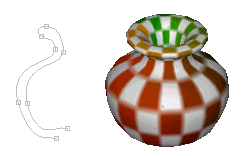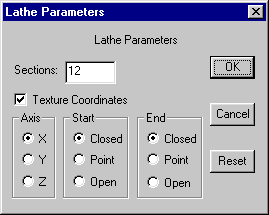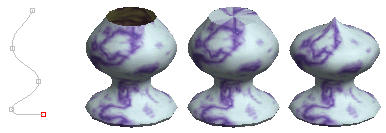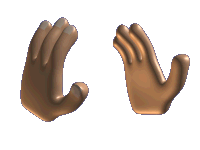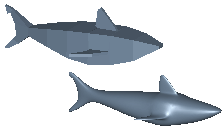Basic Objects
|
You can add new objects to Anim8or
in two ways. The first is to import meshes for the 3ds, lwo,
and obj file formats. You use the object->import menu item to do
this. The second way is to start with one or more built in primitives. The
lower part of the Object/Edit toolbar has several icons for adding new primitives.
|

|
This
button allows you add spheres to an object. First click on it. Then
move the mouse to where you want the sphere to be added. Click and drag
to create a sphere of the size you desire.
|
|
If
you want to add several spheres, use the right mouse button. Using the left
button returns to select mode after adding a single object. |
|
Double
clicking on the sphere brings up a dialog where you can change the sphere's
properties from the default.
|

|
This
button adds cubes. You can divide them into as many subdivisions
in each axis as you like by double clicking on a block to view its properties
dialog.
|

|
This
button adds cylinders. You can taper them, leave the ends open or
closed, and set the number of divisions used to make them in their properties
dialog.
|

|
Add
various platonic solids and other built-in solids with this
button. You can set the current solid type using the build->primitives
menu.
|

|
This
button adds unfilled polygons to an object. They are built as an
editable spline so you can make a lot different shapes starting with the
right polygon. Spline can be filled, extruded, lathed, edited, etc.
To set the number of sides, use the build->primitives->n-gon menu
item.
|

|
You
create True Type text objects with this button. Just click somewhere
in a window and start typing. If you want to change the properties, double
click on the object. You can use any font and style.
|
|
Each
letter it a single spline (possible with multiple parts, like the hole
in an O), and the whole string of characters is grouped together. You can
extrude text objects directly using the Build->Extrude menu item.
|
|
You
can also convert a text object into a group of general-purpose splines using
the Build->Convert_to_Spline menu item.
|

|
This
is the modifier button. Use it to add modifiers, which can bend, stretch,
warp and twist another object into many new shapes. Modifiers are covered
more fully in a later section of this chapter.
|
Each object in Anim8or has its own coordinate system. Its pivot
is located origin. When you scale or rotate and object it is done using
the pivot. When you are in wire frame mode, the pivots of selected objects
are shown as red-green-blue axes as in:
|

|
You can move and rotate pivots by using edit/pivot mode.
|















